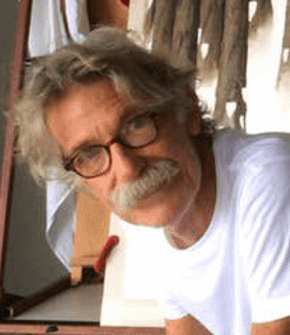Robert Powell

- Profession: Artist
- Country of Origin: Australia
- Date of Birth: 1948
Born in Sydney, Australia, Robert Powell studied English literature, Psychology and Architecture at the University of New South Wales from 1965 to 1972. From 1975 to 1979 he joined architectural practices in London and completed design work for projects throughout the Middle East, including a garden for Prince Khaled of Saudi Arabia. In 1975 Powell began visiting Ladakh (India), and went on drawing houses, stupas and landscapes until 1980. In 1979/80, he also worked in the villages of Kalash and Swat (Pakistan) documenting mosques and wood carvings.
He first came to Nepal in 1980 and rented a house in Chauni near Swayambhu to work on his sketches from Kalash and Swat on larger sheets and in greater detail. The space allowed him to do his paintings and sketches more comfortably. Gradually, he became familiar with Newa bricks, woods and architecture of the Kathmandu valley, which inspired him to sketch and paint the cultural heritages. In 1981, he started his drawing of the courtyard facade of Kuthu Math, which is one of his most celebrated works. He continued his work in Bhaktapur through 1981, later turning his attention to Sankhu and Kathmandu (1982), Gokarna, Pashupatinath and Panauti (1984). From 1981 to 1991, he worked at the paper-making factory run by UNICEF in Bhaktapur designing the products. Meanwhile, He also got involved in some projects as an architect – designing the Machan Wildlife Resort in 1986 and the Pokhara Eye Hospital in 1987.
In 1992 Powell was commissioned by Niels Gutschow and Götz Hagmüller to produce elevation drawings (based on exact measured drawings) of Buddhist votive architecture for the Patan Conservation Development Programme sponsored by German Technical Cooperation (GTZ). In April 1992, and again in 1994, Powell was part of a multi-disciplinary research project, funded by the German Research Foundation, documenting the architectural heritage of Mustang in collaboration with Niels Gutschow, Jaroslav Poncar and Charles Ramble. Until 2000, he worked on a number of Mustang scenes, an experience that encouraged him to make drawings of imaginary architecture. He went around sketching mountain-scapes of Mustang valley, and even documented the Shamanic culture of western Nepal. His exhibitions “Paintings of Mustang” (1999), and “Earth Door, Sky Door” (2000), introduced him to the global art world. His works not just captured ethnographical aspects but also reflected the essence of the Himalaya.
Later he contracted a lung infection and rehabilitated in Europe before moving to Thailand where he spent the rest of his days, painting with acrylics, capturing the scenic beauty around and exploring its spiritual meanings.
N/A
N/A
N/A
N/A